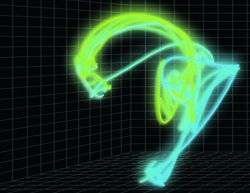Odors classified by networks of neurons

(PhysOrg.com) -- Scientists at the Friedrich Miescher Institute for Biomedical Research (FMI), are unraveling how odors are processed by the brain. As they report in Nature, odors in the olfactory brain are classified into groups represented by discrete activity states of neuronal circuits. Using advanced optical methods, they discovered that gradual variations in odors result in abrupt transitions between patterns of neuronal activity. These findings provide fundamental insights into the brain's information-processing mechanisms.
A sommelier has no difficulty in discriminating between lime, peach and apricot aromas, hints of cinnamon and cedar, or blackberry and cherry notes in the bouquet of a fine wine. For those with a less discerning nose, such subtle differences are difficult to detect. At the same time, however, the sommelier will not perceive a relatively weak background odor, such as perfume. This is because, from the flood of sensory inputs, the human brain extracts certain information and screens out inessential stimuli so as to produce a well-defined perception.
This was the starting point for the study by a team of FMI researchers led by Rainer Friedrich, published in the latest issue of Nature.
Discrete representation of similar odors
Rainer Friedrich's group investigated how the brain responds when an odor is gradually varied. This involved either altering the concentration of a given odor or "morphing" one odor into another similar one. They observed the activity of cells in neuronal circuits of the olfactory bulb, the first center for the processing of olfactory information in the brain.
In zebrafish experiments, the FMI neurobiologists showed that patterns of neuronal activity were largely insensitive to changes in odor concentration. But the situation was quite different when the odor itself was changed: initially, a change in the molecular identity of an odor had little effect, but at a certain point the activity pattern switched, producing a new odor representation. In this abrupt transition, certain neurons were inactivated while others were activated. The pattern of neuronal activity thus represented the odor in a discrete fashion. The researchers concluded that, in the olfactory bulb, different odors are specifically classified and represented by clearly defined neuronal network activity states. These experimental results support theoretical models which neurobiologists have been seeking to confirm for some time.
Decision making also shaped by discrete perceptual categories
The neurons and circuits of the brain have to perform a tricky balancing act: as well as being able to detect minimal changes in sensory input, they are required to disregard what is not important. We should recognize the lime note in the wine but ignore the perfume worn by the person sitting next to us at the wine-tasting event. Neurobiologists have therefore assumed that sensory inputs within a certain range are classified and processed in the same manner. However, this also means that a minimal change in sensory cell activity can abruptly lead to a different classification if it exceeds the defined range. This has now been demonstrated by Friedrich's group for odor representation. But the same principle may also be operative in other brain processes - for example, when we make decisions. Here, too, a small item of additional information or one further impression may often be all that is needed for us to change our mind. Rainer Friedrich, Senior Group Leader at the FMI, comments: "We believe that discrete classification of odors by neuronal circuits reflects a fundamental information-processing strategy which is also likely to be relevant for other brain functions."
Measuring neuronal activity by microscopy
The two keys to the success of this study were a simple animal model - the zebrafish - and a method of microscopy which allows the activity of large numbers of cells in the intact brain to be visualized at high resolution. The latter is important since only a small subset of the neurons are responsible for the abrupt transitions between network states that occur when an odor is gradually varied. Finding these neurons is akin to looking for a needle in a haystack. Using an optical method known as temporally deconvolved multiphoton calcium imaging, the researchers led by Rainer Friedrich were able to analyze thousands of neurons - carefully combing through the haystack.

















